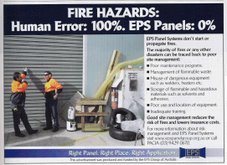 Panorama, the official journal of the AIRAH reports: "The Fire Brigade was called while staff tried unsuccessfully to extinguish the blaze with a fire hose. The building was evacuated when the fire spread to polystyrene sandwich panels lining the ceiling and became too large to fight.... A strong northerly wind blowing through an open roller door in the north wall of the rendering plant building and the volume of polystyrene sandwich panels helped the fire spread quickly to an amenity block on the first floor of the meat processing plant building. It then spread quickly within the meat processing plant but because it had not breached the roof to any extent, it was difficult for fire crews to fight the fire from above using aerial appliances. Instead, they were forced to fight the fire internally using hose reels from fire brigade vehicles. Their task was made more difficult by limited visibility caused by thick black smoke and the complex internal layout of the building."
Panorama, the official journal of the AIRAH reports: "The Fire Brigade was called while staff tried unsuccessfully to extinguish the blaze with a fire hose. The building was evacuated when the fire spread to polystyrene sandwich panels lining the ceiling and became too large to fight.... A strong northerly wind blowing through an open roller door in the north wall of the rendering plant building and the volume of polystyrene sandwich panels helped the fire spread quickly to an amenity block on the first floor of the meat processing plant building. It then spread quickly within the meat processing plant but because it had not breached the roof to any extent, it was difficult for fire crews to fight the fire from above using aerial appliances. Instead, they were forced to fight the fire internally using hose reels from fire brigade vehicles. Their task was made more difficult by limited visibility caused by thick black smoke and the complex internal layout of the building."The final report (Post Incident Analysis & Fire Investigation Report, Post Incident
and Analysis Unit, Metropolitan Fire & Emergency Services Board, Melbourne, 2001) made some broader recommendations in respect to fire safety and risk management. They
included:
"Building regulators and manufacturers are urged to recognise the fire hazards associated with the use of sandwich panels, containing a core combustible insulation, as a building material in non-sprinklered buildings..."
"Australian Standards developed in respect to the fire characteristics of building materials should pay special attention to materials such as sandwich panels containing a core of combustible insulation. In doing so, testing methods similar to those used in the US and Europe should be adopted to determine how such products perform under more realistic fire conditions."

No comments:
Post a Comment